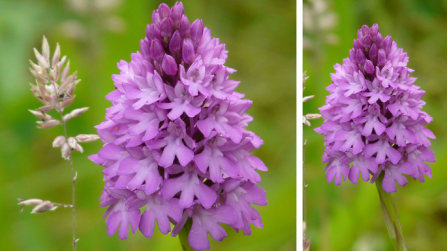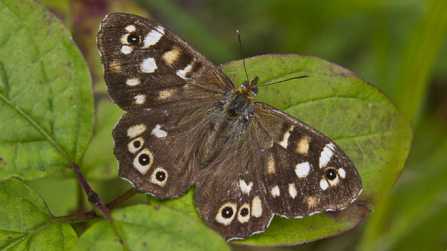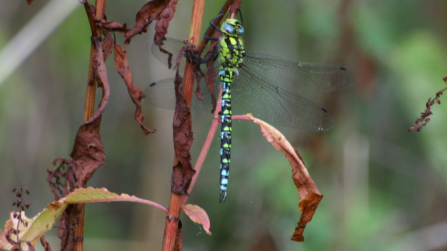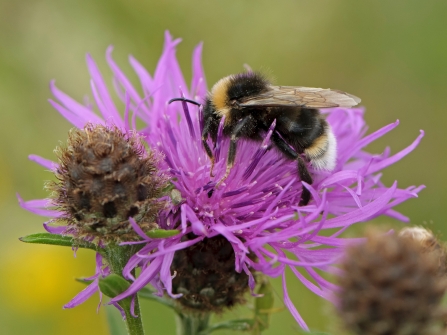
Wildlife to look for in June

Elderflowers
Masses of frothy white flowerheads cover elder trees in June. The flowers provide nectar for a variety of insects, and their sweet scent is unmistakable as you walk past. Later in the year the masses of dark berries are eaten by birds and small mammals.
It was once believed that elder trees warded off evil spirits or witches, so they were planted near houses to keep them safe!

Pyramidal orchids
Pyramidal orchids are fairly widespread in the UK. You often see them growing in roadside verges (another good reason to stop mowing!) as well as chalk grassland, their more typical habitat, so look out for them coming into flower this month.
The flower spikes have a distinctive pyramidal shape, made up of many individual flowers ranging in colour from pale to deep pink.
These orchids are pollinated by day- and night-flying moths, and butterflies.

Speckled wood
Speckled wood butterflies are fairly common, look for them flying in dappled sunlight in woodland.
The adult butterflies rarely feed on flowers, instead they feed on honeydew, which is a sweet liquid produced by aphids.

Otters
Keep an eye out for otters if you’re near a river this summer. You may be lucky to catch a glimpse of them swimming past or spot their spraint, which is said to smell like jasmine tea (if you get that close)!

Stag beetles
Look out for stag beetles flying around on warm evenings in June. These are one of our largest beetles. They’re named after the males’ large jaws, which are said to resemble the antlers of a stag.
The adults are short-lived (no more than a couple of months) but their larvae spend several years hidden underground where they feed on rotting wood. Look for them on woodland edges, in hedgerows, parks and gardens.

Southern hawker by Brian Walker
Southern hawkers
Southern hawkers are large dragonflies, which emerge from ponds as adults from June onwards. You may see them flying right through into the autumn if the weather is good enough.
They are a common dragonfly of ponds, lakes and canals, particularly near to woodland. Hawkers are the largest and fastest-flying dragonflies; they hover, catch their insect-prey mid-air, and can even fly backwards!

Starling fledglings by Vine House Farm
Baby birds and fledglings
You might notice baby birds and fledglings around this month. It is normal for some fledglings to spend a few days on the ground. Their parents are usually nearby keeping a watchful eye so you don't need to do anything for them, however, if you have cats, keep them inside until the birds have gone.
If you're worried about any birds in your garden have a look at the link below for lots more information.

Knapweed
Knapweed should be coming into flower this month, adding a splash of pink and purple to meadows, grassland, and even road verges and some gardens that have been left uncut.
This thistle-like plant is a great source of nectar for insects, and later in the year the seeds provide food for birds.

Peacock and red admiral by Richard Burkmar
Red admirals
The red admiral is an unmistakeable garden visitor. This black and red beauty may be seen feeding on flowers on warm days all year-round. Adults are mostly migrants from north Africa and continental Europe so sightings are most common in summer months, but some do hibernate here.

Yellow rattle
Yellow rattle
Yellow rattle is an important plant in wildflower meadows. It is semi-parasitic, feeding off the nutrients in roots of grasses. This weakens the grasses and allows more delicate wild flowers the space to grow.
As summer goes on the yellow flowers dry and form brown, papery seed pods that rattle with seeds when shaken, giving them their name.
If you're turning part of your garden into a wild patch, scattering yellow rattle seeds in autumn is a good way to help as it will weaken the grasses in your lawn too.
Stay connected with others
Join our online community, linked by a love of nature and wildlife.
Follow us on Twitter, Facebook and Instagram. We share lots of beautiful photos of local wildlife, ideas to enjoy nature near you and easy ways to help wildlife.
You can join our friendly Facebook group to share photos of wildlife that you’ve seen in your garden, get help identifying any you’re not sure about, and share ideas for getting your daily dose of nature.

